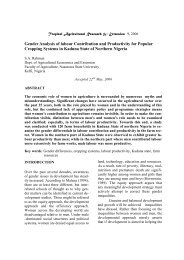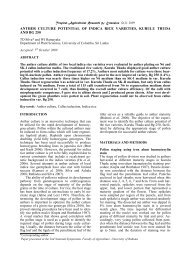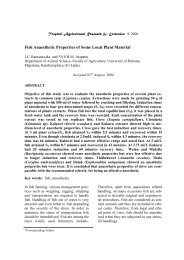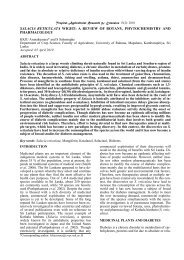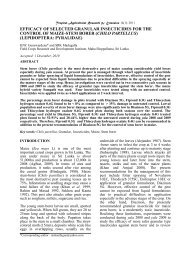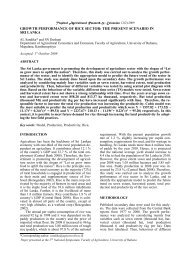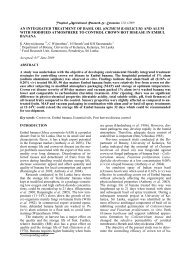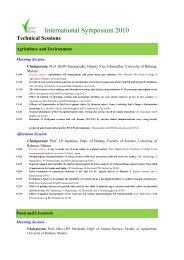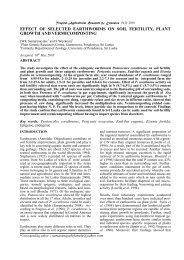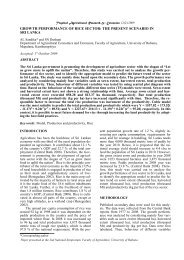modification of solar distillation unit to increase efficiency in drinking ...
modification of solar distillation unit to increase efficiency in drinking ...
modification of solar distillation unit to increase efficiency in drinking ...
Create successful ePaper yourself
Turn your PDF publications into a flip-book with our unique Google optimized e-Paper software.
Tropical Agricultural Research & Extension 12(2):2009<br />
MODIFICATION OF SOLAR DISTILLATION UNIT TO INCREASE EFFICIENCY IN<br />
DRINKING WATER PRODUCTION FROM SALINE WATER<br />
MDHJ Senavirathna 1* , KDN Weeras<strong>in</strong>ghe 1 , Mathias Maier 2 , Harald Rosemann 2<br />
1 Department <strong>of</strong> Agric. Eng<strong>in</strong>eer<strong>in</strong>g, Faculty <strong>of</strong> Agriculture, University <strong>of</strong> Ruhuna, Mapalana, Kamburupitiya<br />
2 Std werke Karlsruhe, Dexlander str 72, 76127 Karlsruhe, Germany<br />
Accepted: 29 th September 2009<br />
ABSTRACT<br />
Solar <strong>distillation</strong> is one <strong>of</strong> the appropriate methods which could use <strong>to</strong> reduce cost <strong>of</strong> power <strong>in</strong> the process<br />
<strong>of</strong> water purification. The commonly used s<strong>in</strong>gle bas<strong>in</strong> <strong>solar</strong> <strong>distillation</strong> systems are not efficient <strong>in</strong><br />
the process <strong>of</strong> <strong>distillation</strong>. Therefore, an experiment was carried out <strong>to</strong> <strong><strong>in</strong>crease</strong> the <strong>efficiency</strong> <strong>of</strong> the exist<strong>in</strong>g<br />
s<strong>in</strong>gle bas<strong>in</strong> <strong>solar</strong> <strong>distillation</strong> <strong>unit</strong> constructed by the NERD center Sri Lanka by <strong>in</strong>corporat<strong>in</strong>g a<br />
2cm thick unsieved river sand layer for heat retention due <strong>to</strong> its high thermal capacity. It was revealed<br />
that, 30% <strong>in</strong>crement <strong>of</strong> water <strong>distillation</strong> could be achieved when sand is <strong>in</strong>corporated <strong>to</strong> the <strong>solar</strong> <strong>distillation</strong><br />
system even though the <strong>in</strong>ternal temperatures <strong>of</strong> the both systems were not significantly different.<br />
Average daily production <strong>of</strong> the <strong>solar</strong> <strong>distillation</strong> system constructed by the NERD center was<br />
1557ml/m 2 /day <strong>in</strong> Mapalana (6°3'39"N 80°33' 57"E). The average daily production after the <strong>modification</strong><br />
was 2017.50ml/m 2 /day <strong>in</strong> Mapalana. The maximum <strong>distillation</strong> rate <strong>of</strong> NERD <strong>solar</strong> distiller was<br />
2150ml/m 2 /day and 2780mi/m 2 /day for the modified <strong>solar</strong> distiller dur<strong>in</strong>g the experiment period. The<br />
average <strong>in</strong>ner temperatures <strong>of</strong> NERD and modified <strong>solar</strong> distillers were 55.88 0 C and 56.54 0 C, respectively<br />
when the average ambient temperature was 29.02 0 C. Evaporation <strong>of</strong> more water from the modified<br />
<strong>solar</strong> distiller was the reason for <strong>in</strong>significant temperature differences between two <strong>solar</strong> distillers.<br />
Key words: Sand, Solar <strong>distillation</strong>, Purification<br />
INTRODUCTION<br />
Solar <strong>distillation</strong> systems are appropriate low cost<br />
methodologies <strong>to</strong> produce dr<strong>in</strong>k<strong>in</strong>g water from<br />
sala<strong>in</strong>e water. Solar <strong>distillation</strong> process removes<br />
impurities such as salts and heavy metals as well as<br />
microbiological organisms. Most <strong>of</strong> the people near<br />
coastal areas may face with the unavailability <strong>of</strong><br />
fresh water due <strong>to</strong> sea water <strong>in</strong>trusion <strong>in</strong><strong>to</strong> groundwater<br />
aquifers. It has been reported that due <strong>to</strong><br />
higher fluoride and other ions, people face health<br />
problems <strong>in</strong> North and North Central prov<strong>in</strong>ces <strong>of</strong><br />
Sri Lanka.<br />
The <strong>solar</strong> energy has been used for many years<br />
<strong>in</strong> obta<strong>in</strong><strong>in</strong>g potable water by <strong>distillation</strong> from contam<strong>in</strong>ated<br />
or brackish supplies (Ihalawela and Careem<br />
2007). As early as 1561, Arabs used <strong>solar</strong> distillers<br />
<strong>to</strong> obta<strong>in</strong> dr<strong>in</strong>kable water as well as water<br />
based fragrances. In 1861, the French used <strong>solar</strong><br />
stills <strong>to</strong> produce Brandy from w<strong>in</strong>e. In 1872, <strong>in</strong> Las<br />
Sal<strong>in</strong>as, Chile' a <strong>solar</strong> still made <strong>of</strong> 64 water bas<strong>in</strong>s<br />
constructed from wood with slop<strong>in</strong>g glass covers<br />
was used <strong>to</strong> supply water <strong>to</strong> animals work<strong>in</strong>g <strong>in</strong> the<br />
local m<strong>in</strong>es. Even the United States military <strong>in</strong>cludes<br />
<strong>solar</strong> stills <strong>in</strong> their survival kits (Speirs<br />
2007).<br />
Apart from the <strong>solar</strong> <strong>distillation</strong>, there are various<br />
technologies such as Reverse Osmosis (RO),<br />
Electrodialysis (ED), Ion-Exchange (IE), Mechanical<br />
Filters (MF) etc for water purification<br />
(Avvannavar et al. 2008). However, energy cost<br />
and operational and ma<strong>in</strong>tenance cost <strong>in</strong>curred<br />
these methodologies <strong><strong>in</strong>crease</strong>s the production cost<br />
<strong>of</strong> dr<strong>in</strong>k<strong>in</strong>g water. (Rodrígueza and Camachob<br />
1999). Production cost without labor charges is<br />
around Rs.150/- <strong>to</strong> Rs. 500/- per cubic meter by<br />
Reverse Osmosis and for other methods the cost<br />
may be at same range (www.oas.org - 2009).<br />
Use <strong>of</strong> the <strong>solar</strong> energy for the <strong>distillation</strong> <strong>of</strong><br />
water is one <strong>of</strong> the appropriate methods <strong>to</strong> reduce<br />
the cost <strong>in</strong>curred on power when other methodologies<br />
are used. The ma<strong>in</strong> drawback associated with<br />
the <strong>solar</strong> <strong>distillation</strong> systems are low <strong>distillation</strong><br />
<strong>efficiency</strong>. The <strong>solar</strong> distiller <strong>in</strong>troduced by the<br />
NERD Sri Lanka is a s<strong>in</strong>gle chamber type and also<br />
perform<strong>in</strong>g poor <strong>distillation</strong> <strong>efficiency</strong>. Therefore,<br />
the present experiment was <strong>to</strong> <strong>in</strong>corporate a feasible<br />
technology <strong>to</strong> <strong><strong>in</strong>crease</strong> the <strong>efficiency</strong> <strong>of</strong> the <strong>solar</strong><br />
distillers. In this experiment the performance <strong>efficiency</strong><br />
<strong>of</strong> the 1 m 2 size s<strong>in</strong>gle bas<strong>in</strong> <strong>solar</strong> distiller<br />
manufactured by NERD center was tested, when<br />
sand is placed under the black plated corrugated<br />
metal sheet that is expected <strong>to</strong> <strong><strong>in</strong>crease</strong> the thermal<br />
capacity.<br />
The <strong>in</strong>tensity <strong>of</strong> <strong>solar</strong> energy received by the<br />
distiller is the s<strong>in</strong>gle most important parameter affect<strong>in</strong>g<br />
the water production (Happer 2007). The<br />
daily distilled water output (M e <strong>in</strong> kg/m 2 /day) is<br />
the amount <strong>of</strong> energy utilized <strong>in</strong> vaporiz<strong>in</strong>g water <strong>in</strong><br />
the distiller (Q e <strong>in</strong> J/m 2 /day) divided by the latent<br />
*Correspond<strong>in</strong>g author<br />
Paper presented at the 2nd National Symposium, Faculty <strong>of</strong> Agriculture, University <strong>of</strong> Ruhuna
64<br />
heat <strong>of</strong> vaporization <strong>of</strong> water (L <strong>in</strong> J/kg). Solar distiller<br />
<strong>efficiency</strong> (n) is the amount <strong>of</strong> energy utilized<br />
<strong>in</strong> vaporiz<strong>in</strong>g water <strong>in</strong> the distiller over the amount<br />
<strong>of</strong> <strong>in</strong>cident <strong>solar</strong> energy on the distiller (Q t <strong>in</strong> J/m 2 /<br />
day).Thus <strong>solar</strong> distiller production and efficiencies<br />
could be expressed as below (equation 1 and 2).<br />
Accord<strong>in</strong>g <strong>to</strong> the available data the typical <strong>efficiency</strong><br />
for s<strong>in</strong>gle bas<strong>in</strong> <strong>solar</strong> distiller is reach<strong>in</strong>g<br />
only <strong>to</strong> 60%. (http://www.solaqua.com/ solstilbas.html).<br />
Daily distilled output: M e = Q e / L - (1)<br />
Daily distilled <strong>efficiency</strong>: n = Q e / Q t - (2)<br />
Therefore, <strong>to</strong> <strong><strong>in</strong>crease</strong> the production <strong>of</strong> a <strong>solar</strong><br />
distiller, area <strong>of</strong> the <strong>solar</strong> distiller or heat conversion<br />
<strong>efficiency</strong> should be <strong><strong>in</strong>crease</strong>d. However, <strong><strong>in</strong>crease</strong><br />
<strong>in</strong> <strong>efficiency</strong> is more viable approach than<br />
<strong><strong>in</strong>crease</strong> <strong>in</strong> distiller size ow<strong>in</strong>g <strong>to</strong> several reasons<br />
<strong>in</strong>clud<strong>in</strong>g cost <strong>of</strong> production, handl<strong>in</strong>g and fix<strong>in</strong>g.<br />
MATERIALS AND METHODS<br />
MDHJ SENAVIRATHNA ET AL : SOLAR DISSTILLATION OF WATER<br />
NERD <strong>solar</strong> distiller and <strong>modification</strong> done<br />
The <strong>solar</strong> distiller manufactured by NERD center is<br />
a s<strong>in</strong>gle bas<strong>in</strong> type and has 3 ma<strong>in</strong> parts, glass<br />
sheet, <strong>to</strong>p opened rectangular metal case and black<br />
pa<strong>in</strong>ted corrugated metal sheet. The <strong>to</strong>p side <strong>of</strong> the<br />
rectangular shape metal box (125cm X 85cm X<br />
12cm) was covered with a 3mm thick non colored<br />
general purpose pla<strong>in</strong> glass sheet and, the corrugated<br />
metal plate was fixed with<strong>in</strong> the box. The<br />
black pa<strong>in</strong>ted corrugated metal plate <strong>of</strong> the <strong>solar</strong><br />
distiller conta<strong>in</strong>s the brackish water which is directly<br />
exposed <strong>to</strong> the <strong>solar</strong> energy Figure 1. The<br />
polluted water is completely enclosed <strong>in</strong> an air-tight<br />
condition <strong>in</strong>side the <strong>solar</strong> distiller <strong>unit</strong>. The <strong>in</strong>cident<br />
<strong>solar</strong> radiation passes through the transparent glass<br />
cover which is cover<strong>in</strong>g upper side <strong>of</strong> the distiller<br />
and is absorbed by the black pa<strong>in</strong>ted metal sheet,<br />
the absorbed heat is then transferred <strong>to</strong> the water<br />
without significant energy loss. The polluted water<br />
get heated and evaporated. The formed vapor on<br />
the water surface start mov<strong>in</strong>g <strong>in</strong> an upward direction<br />
due <strong>to</strong> the created driv<strong>in</strong>g force (convective<br />
currents) and temperature difference between the<br />
Metal sheet<br />
water and glass cover which is get <strong>in</strong> <strong>to</strong> comparatively<br />
low temperature due <strong>to</strong> heat loss by convection.<br />
When the water vapor comes <strong>in</strong> contact with<br />
the glass, the vapor will condense <strong>to</strong> small-size<br />
droplets <strong>of</strong> freshwater. The condensate starts mov<strong>in</strong>g<br />
down along the <strong>in</strong>cl<strong>in</strong>ed glass cover due <strong>to</strong> the<br />
gravitational force, which will be collected from the<br />
collect<strong>in</strong>g channel which is connected <strong>to</strong> the lower<br />
side <strong>of</strong> the <strong>in</strong>cl<strong>in</strong>ed glass sheet (Tarawneh 2007).<br />
Modified Sand Layered Solar distiller<br />
Same dimensions and materials used for the NERD<br />
<strong>solar</strong> distiller ware used for the construction <strong>of</strong><br />
modified <strong>solar</strong> distiller and only the sand bas<strong>in</strong>g<br />
was the extra component used <strong>in</strong> the modified distiller.<br />
A 2cm well dried unsieved river sand layer<br />
was placed under the water hold<strong>in</strong>g corrugated<br />
metal sheet <strong>of</strong> the <strong>solar</strong> distiller as illustrated <strong>in</strong> the<br />
Figure 2. A rectangular metal bas<strong>in</strong> made <strong>of</strong> 1 mm<br />
thick z<strong>in</strong>c coated metal sheet with depth <strong>of</strong> 2.2cm,<br />
length <strong>of</strong> 124.5cm and width <strong>of</strong> 84.5cm was used <strong>to</strong><br />
place sand layer. Approximately 8kg <strong>of</strong> dry sand<br />
was evenly applied <strong>in</strong>side the sand bas<strong>in</strong>. Thereafter,<br />
the corrugated metal sheet was placed tightly<br />
on sand layer and sealed the edges sheet with the<br />
walls <strong>of</strong> the sand bas<strong>in</strong> us<strong>in</strong>g silicon glue.<br />
Meteorological data<br />
Ra<strong>in</strong>fall data <strong>of</strong> the experiment period were taken<br />
from the meteorological station Faculty <strong>of</strong> Agriculture,<br />
University <strong>of</strong> Ruhuna, Mapalana. Ra<strong>in</strong>fall data<br />
were collected at daily basis. The ambient temperature<br />
was taken at hourly <strong>in</strong>terval from 8.00 am <strong>to</strong><br />
4.00 pm dur<strong>in</strong>g the experiment. The average ambient<br />
temperature dur<strong>in</strong>g the experiment was 30.2 0 C.<br />
The observation period was a dry period with less<br />
than 2mm average ra<strong>in</strong>fall per day.<br />
Field Validation<br />
Performance <strong>of</strong> the modified <strong>solar</strong> distiller by <strong>in</strong>corporat<strong>in</strong>g<br />
the sand layer was tested aga<strong>in</strong>st the<br />
exist<strong>in</strong>g distiller <strong>in</strong> the Science Park, Faculty <strong>of</strong><br />
Agriculture, University <strong>of</strong> Ruhuna, Mapalana, Sri<br />
Lanka dur<strong>in</strong>g June – July 2008. Both <strong>unit</strong>s were<br />
placed at 35 0 angle at East-West direction <strong>to</strong> avoid<br />
errors due <strong>to</strong> the orientation. Dur<strong>in</strong>g the field validation,<br />
pipe born water was used and distillers were<br />
recharged as it were gett<strong>in</strong>g dried. Water <strong>distillation</strong><br />
rate <strong>of</strong> the two <strong>unit</strong>s was measured at hourly <strong>in</strong>tervals<br />
from 8.00 am – 4.00 pm, <strong>of</strong> the day and <strong>in</strong>ternal<br />
temperatures <strong>of</strong> both <strong>unit</strong>s were also taken at<br />
the time <strong>of</strong> observations.<br />
5cm<br />
2cm<br />
9cm<br />
Figure 1: Solar distiller <strong>in</strong>side view<br />
Sand Layer Water Layer Corrugated metal sheet Glass Sheet<br />
Figure 2: Sand layer beneath the corrugated metal<br />
sheet
Tropical Agricultural Research & Extension 12(2):2009<br />
65<br />
ml<br />
3000<br />
2500<br />
2000<br />
1500<br />
1000<br />
500<br />
0<br />
1 2 3 4 5 6 7 8 9 10 11 12 13 14 15 16 17 18 19 20<br />
Observations (Days)<br />
Total (Sand layered)<br />
Total(Reference)<br />
RESULTS AND DISCUSSION<br />
Average production (Modified) - 2017.5ml<br />
Average production (Available) - 1558.5ml<br />
Figure 3: Daily distilled water production. Average<br />
production (Modified) - 2017.5ml. Average production<br />
(Available) - 1558.5ml<br />
Table 1: Water production, temperatures and ra<strong>in</strong>fall<br />
statistics<br />
Date Total water Production<br />
Internal Average Ra<strong>in</strong>fall<br />
production<br />
temperature Ambient (mm)<br />
(mm) difference<br />
<strong>of</strong> the distiller<br />
( o C)<br />
temp<br />
(C O )<br />
Mod Ref (%) Mod Ref<br />
08-06-11 2045 1480 38.18 - - 38.2 0.1<br />
08-06-12 1650 1190 38.66 50.7 49.8 31.7 0.1<br />
08-06-13 2370 1715 38.19 56 55.6 32.8 5.7<br />
08-06-14 1680 1280 31.25 - - 29 1.3<br />
08-06-16 2150 1605 33.96 - - 29.7 0.7<br />
08-06-17 1630 1140 42.98 - - 30.3 3.3<br />
08-06-19 2350 1770 32.77 86.4 84.4 29.3 1.3<br />
08-06-20 2400 1840 30.43 89.6 88.3 30.7 0<br />
08-06-21 1960 1500 30.67 90.8 90.5 29.3 11.1<br />
08-06-25 1370 1130 21.24 49.6 49.1 28.3 4.4<br />
08-06-27 2660 1975 34.68 57.9 57 27.9 0<br />
08-06-30 2225 1730 28.61 60.2 59.9 28 1.4<br />
08-07-01 1530 1270 20.47 48.9 48.6 28 0<br />
08-07-02 2355 1880 25.27 63.2 62.1 28.3 0<br />
08-07-03 1790 1540 16.23 60.1 58.1 27.3 0<br />
08-07-04 1870 1510 23.84 60.8 59.8 28.9 0.3<br />
08-07-05 2100 1780 17.98 62.6 62.6 29.9 2.7<br />
08-07-07 1335 1015 31.53 49.4 49.7 31.1 3<br />
08-07-09 2780 2150 29.30 60.8 60.9 33.6 0.9<br />
08-07-10 2100 1670 25.75 59.7 58.7 32.7 3.6<br />
Average 2017.5 1558.5 29.6 62.9 62.2 30.2 2.00<br />
C o<br />
100<br />
90<br />
80<br />
70<br />
60<br />
50<br />
40<br />
30<br />
20<br />
10<br />
0<br />
1 2 3 4 5 6 7 8 9 10 11 12 13 14 15 16 17 18 19 20<br />
days<br />
Tot. Mod.Temp. Tot. Ref. Temp. Avg Ambiant temp<br />
Figure 4: Variation <strong>of</strong> <strong>in</strong>ternal temperatures <strong>of</strong> <strong>distillation</strong><br />
<strong>unit</strong>s and ambient temperature<br />
It was found that the average production rates <strong>of</strong><br />
water was 2017.5 ml/m 2 /day and 1558.5 ml/m 2 /day<br />
for modified <strong>solar</strong> distiller and the conventional<br />
<strong>solar</strong> distiller respectively. The average production<br />
difference between two <strong>solar</strong> distillers was 460.5ml<br />
which is a 29.6% <strong>in</strong>crement <strong>in</strong> production. Results<br />
obta<strong>in</strong>ed from the two distiller <strong>unit</strong>s are given <strong>in</strong> the<br />
Table 1.<br />
Water <strong>distillation</strong> patterns have closer similarities<br />
for both distillers with a dist<strong>in</strong>ct percentage<br />
<strong><strong>in</strong>crease</strong> <strong>in</strong> the modified distiller. However, the<br />
daily production between two <strong>unit</strong>s were significantly<br />
differed (T test P value ~ 0.000) and production<br />
difference is <strong>in</strong>creas<strong>in</strong>g with the <strong><strong>in</strong>crease</strong> production<br />
at an accelerated rate.<br />
The <strong>in</strong>ternal temperatures <strong>of</strong> both <strong>unit</strong>s were<br />
not sigificantly differed (T test P value > 0.05) and<br />
it has been fluctuated <strong>in</strong> the range <strong>of</strong> 48 0 C <strong>to</strong> 91 0 C.<br />
It was evident that there is no significat effect on<br />
production rate <strong>of</strong> two distiltion <strong>unit</strong>s by difference<br />
<strong>in</strong> <strong>in</strong>ternel temperatures <strong>of</strong> two <strong>unit</strong>s with<strong>in</strong>g the 5<br />
percent confidence level. In the other hand, ambient<br />
temperature is significantly correlated <strong>to</strong> the <strong>distillation</strong><br />
rate <strong>of</strong> the both distiller <strong>unit</strong>s (P value
66<br />
MDHJ SENAVIRATHNA ET AL : SOLAR DISSTILLATION OF WATER<br />
Happer GDJ 2007 Solar energy projects for the Evil<br />
Genius, Mc Grow Hill Coperations, pp 59<br />
Ihalawela PHCA and Careem MA 2007 A Cheap<br />
Au<strong>to</strong>matic Solar Water Distiller, “Proceed<strong>in</strong>gs<br />
<strong>of</strong> the Technical Sessions 23”, pp 41-45. Institute<br />
<strong>of</strong> Physics, Sri Lanka<br />
Rodrígueza LG and Camachob CG 1999 Prelim<strong>in</strong>ary<br />
design and cost analysis <strong>of</strong> a <strong>solar</strong> <strong>distillation</strong><br />
system, “Solar Energy”. pp 109–114 Departamen<strong>to</strong><br />
Física Fundamental Experimental,<br />
Universidad de La Laguna, 38205 La Laguna<br />
(Tenerife), Canary Islands, Spa<strong>in</strong><br />
Speirs R 2007 Solar Distillers. http://www. gomes-<br />
tic.com/Emergency-Preparation/Solar-<br />
Distillers.32567 12/10/2008<br />
Suleiman M and Tarawneh K Effect <strong>of</strong> Water<br />
Depth on the Performance Evaluation <strong>of</strong> Solar<br />
Still, 2007 “Jordan Journal <strong>of</strong> Mechanical and<br />
Industrial Eng<strong>in</strong>eer<strong>in</strong>g” Volume 1, Number 1,<br />
pp25<br />
http://www.oas.org/dsd/publications/Unit/oea59e/<br />
ch20.htm 22/08/2009 Desal<strong>in</strong>ation by reverse<br />
osmosis<br />
http://www.solaqua.com/solstilbas.html 8/8/2008<br />
Solar Still Basics.



